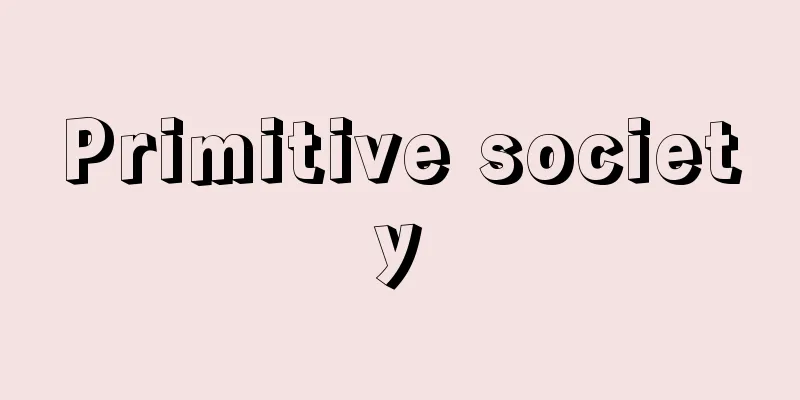Primitive society

|
It refers to a society in which a primitive lifestyle is lived or which is at a primitive cultural stage. MeaningThe word "primitive" has existed in China since ancient times, and as seen in the "Book of Changes" (part 1 of the Xia Ci), where it means "to seek the beginning" or "to investigate the roots", Yoshio Takeuchi's famous work "The Primitive Beginnings of Laozi" (1928) is an example of "primitive" being used in this sense. In modern times, the words "primitive" (adjective) and "primitive" were adopted as translations of the English word "primitive" in China and Japan, and the meaning of "original beginning" was added to "primitive". The English word primitive and the French word primitif come from the Latin word primitivus ("first" or "early"). The Romans used the word ferus or barbarus from Greek to mean "barbarous", but they did not use the word primitivus in that sense. The Greeks and Romans believed that their ancestors were originally in a crude state, just like the barbarians around them. And the important point is that this way of thinking was inherited by medieval Europeans. These Europeans, who have been advancing overseas since the 16th century and have come into contact with many uncivilized peoples in various places in Africa, America, Oceania, etc., came to regard the culture or society of these peoples as similar to that of ancient peoples, and began to use the word primitive to describe their uncivilized state. What is most noteworthy is that the adjective "primitive" was used to describe both the ancestors of modern civilized peoples and the current uncivilized peoples. In other words, the words primitive, primitif, and primitiv (German) came to be used by medieval and modern Europeans as adjectives to vaguely refer to low-level cultures and low-class societies, regardless of whether they were new or old. An example of this usage can be clearly seen in Primitive Culture (1871), a masterpiece by Tylor, who established the foundations of anthropological research in Britain. His methodology was to search for "survivals" of ancient cultural elements passed through by the ancestors of civilized peoples among present-day uncivilized peoples, and to synthesize them in an attempt to reconstruct the "early history" of civilized peoples. [Fumiei Tsunoda] Concepts of "Primitive Society"So what exactly does "primitive" mean? This question was actively debated among cultural anthropologists and ethnologists in Europe and America, but in the end, it was decided that the term "primitive" describes a state in which there is no national life, or if it is, it is still a tribal state, society is strictly regulated by the community, writing is not yet used, monetary economy is not practiced, and metallurgy is adopted but is underdeveloped. German and Austrian scholars sometimes used the term "Naturvölker" as the same meaning as "primitive peoples." The term "uncivilized" also has a similar meaning to "primitive," but this term was often applied to modern lower-class peoples. In 1887, the American Robert Morgan published his famous book Ancient Society. In it, he broadly divided history into the barbaric and civilized periods, and further divided the barbaric period into two stages: savagery and barbarism. This way of thinking had a strong influence on Engels, and through him it was inherited by the Soviet historical academic community. Nineteenth-century anthropologists and ethnologists such as Tylor and Morgan considered modern primitive societies to be roughly the same as the ancient societies of civilized people. They investigated primitive societies not to investigate primitive societies themselves, but as a means to reconstruct the ancient societies of civilized people. In the twentieth century, this methodology was supported and refined by German and Austrian scholars of the historical ethnology school (Glebner, Wilhelm Schmidt, and others). In their view, modern primitive peoples can be classified into several cultural areas (Kulturkreis) according to the type of cultural complex, and by arranging these cultural areas in a developmental sequence, the various stages of development in ancient history become clear. The above-mentioned evolutionary and historical ethnological research into primitive societies was attacked by archaeology, which has made a significant contribution to the elucidation of ancient cultures and societies through the research and investigation of remains and ruins, and the newly emerging functionalist ethnology, and was rejected as a methodological approach. In other words, the basic claim of the new ethnology (which began with functionalism, passed through configurationism, and has reached modern ethnology) is that ethnology aims to study the societies and cultures of various peoples themselves, and should not be studied as a means to elucidate ancient societies. Although the word "primitive" is used by these new ethnologists, it is used in reference to modern uncivilized peoples, as clearly stated in the famous book Primitive Society (1920) by the American author Lowy. Since there are many commonalities between ancient societies and the societies of modern primitive peoples, in that they both have low-level cultures, it is natural that research on one should take into account the results of research on the other, but since the 1940s there has been a notable trend in Western academic circles that the two should be studied separately. The societies of modern primitive peoples, due to their stagnation and contact with more advanced cultures or peoples from outside, are more distorted and complex than societies of antiquity. Therefore, it is impossible to narrow both of them down to the concept of "primitive" simply because their cultures are low-grade, and this would result in a lack of academic rigor. In other words, the term "primitive" is a general concept (which simply means a low-grade culture), not a historical concept. Ancient societies spanned at least two million years, and several stages of development can be recognized during that long period. The era in which people lived on an acquisition economy based on hunting, gathering, and fishing was the oldest and longest, but even this was subdivided into (1) the era before the use of fire, (2) the era before the invention of the bow and arrow, and (3) the era in which people learned about bows and arrows, hunted alone, and engaged in fishing. This was followed by the early agricultural era, when agriculture and animal husbandry began (productive economy) and metallurgy began, and in recent years the aspects of this early agricultural culture have been rapidly revealed in various parts of the Old Continent, including the Orient. Archaeology is the main research field in this field, and the results of ethnology research are only used as a reference for the study of ancient societies. As mentioned above, in Western academic circles, the concept of "primitive society" is used to describe modern and contemporary uncivilized societies. It is no longer applied to ancient societies, so the term "primitive era" does not appear there. Japan, Korea, and China are probably the only countries that use the terms "primitive era" and "primitive society" to describe ancient history and societies. Soviet scholars use the adjective "primitive" (первобытный/pervobïtnïy) to refer to ancient societies, and "primitive" (примитивный/primitivnïy) to refer to modern uncivilized societies, and they make a strict distinction between the two. [Fumiei Tsunoda] Research on "primitive societies" in Japan and AmericaUntil the end of the war, the general period division of Japanese history was the Age of the Gods (or prehistory) → Ancient → Middle Ages... After the war, the historical accuracy of myths was denied, while at the same time, archaeological research and investigations made great strides, and the "Age of the Gods" or "Prehistory" was replaced with "Primitive", and period divisions such as Primitive → Ancient → Middle Ages... became fashionable. In terms of the trends in historical research around the world, this period division goes against the trend. Moreover, it is highly unreasonable to confine three periods with different characteristics - the Pre-Pottery Period, the Jomon Period, and the Yayoi Period - to a single concept of the "primitive period". Japanese scholars also made a big mistake by translating Marx's "urwüchsige kommunistische Gesellschaft" ( primitive communist society) as " primitive communist society". The situation is somewhat different in the Americas. Pre-Colombian cultures here do not date back to the first half of the Late Paleolithic period, and did not develop to the stage of dynastic culture as seen in Egypt, Mesopotamia, China, and India. Moreover, the ancient cultures of America are connected or transferred to the Indian cultures without any break or gap. In other words, in the Americas, there is no distinction between ancient societies and modern primitive societies. In this context, physical anthropology, so-called "prehistory" or (cultural) anthropology as a comprehensive science that includes archaeology, linguistics, sociology, human ecology, ethnology, psychology, and religious studies, has been advocated in the United States, and there is a noticeable tendency to study the culture and society of the Indians from ancient times to the present from this perspective. In recent years, new archaeology, which is based on the neo-evolutionary theory and makes full use of various methods from natural sciences, has been playing a major role in the research and investigation of primitive Indian cultures. However, even among these cultural anthropologists, there have been no attempts to view the ancient societies of America as "primitive societies." [Fumiei Tsunoda] "Primitive Societies" by G. Lowy, translated by Kawamura Tadao (1939, Tokyo Daiichi Publishing)" ▽ "Prehistoric Societies" by G. Clark and S. Piggott, translated by Tanabe Yoshikazu and Umehara Tatsuji (1970, Hosei University Press)" ▽ "History of American Archaeology" by G. Willey and J. A. Sabloff, translated by Kotani Yoshinobu (1979, Gakuseisha)" ▽ "History of Primitive Societies" by Lin Yaohua (1984, Beijing, China India Bureau)" [References] | | | |Source: Shogakukan Encyclopedia Nipponica About Encyclopedia Nipponica Information | Legend |
|
原始的生活が営まれている社会、または原始的な文化段階にある社会をいう。 語義「原始」という語は古くから中国にあったが、『易経』(繋辞(けいじ)上)に「原始反終」とみえるように、「始めを原(たず)ねる」、「根原を推し究める」という意味をもっていた。武内義雄(たけうちよしお)の名著『老子原始』(1928)は、「原始」をその意味に用いた例である。近代に至って中国や日本では英語のprimitiveの訳語として「原始」(形容詞)、「原始的」の語が採用され、「原始」に「元始」という意味が加わった。 英語のprimitiveやフランス語のprimitifなどは、ラテン語のprimitivus(「最初の」「初期の」)に由来している。ローマ人は、「野蛮な」を意味することばとしてferusまたはギリシア語からきたbarbarusを用いたけれども、primitivusという語をそのような意味には使わなかった。ギリシア、ローマ人は、彼らの祖先たちも、最初は周辺の野蛮人と同じように、粗野な状態にあったと考えていた。そして重要な点は、この思考は中世のヨーロッパ人に受け継がれていたことである。このヨーロッパ人が16世紀以来しきりに海外に進出し、アフリカ、アメリカ、オセアニアなどの各地で幾多の未開民族に接するようになると、これら諸民族の文化ないし社会は遠古の人間のそれらに類するとみなし、その未開状態を形容する語としてprimitiveということばを用いるようになった。もっとも注意されるのは、この「原始的」という形容詞が、近代の文明人の祖先と現存の未開民族の両方に関して使用されたことである。つまりprimitive, primitif, primitiv(ドイツ語)の語は、中世・近代のヨーロッパ人によって、低度の文化、低級な社会を、新古の別なく漠然とさす形容詞として用いられるようになった。こうした使用例は、イギリスにおける人類学的研究の基礎をつくったタイラーの名著『原始文化』Primitive Culture(1871)に端的に認められる。彼の方法論は、現在の未開民族のなかに、文明人の祖先たちが通過した遠古の文化諸要素の「残存」survivalsを捜し求め、それらを総合して文明人の「初期の歴史」early historyを再構成しようとすることにあった。 [角田文衛] 「原始社会」の諸概念それならば、「原始的」とは具体的にどのような状態をさすのであろうか。この問題は、ヨーロッパやアメリカの文化人類学者や民族学者たちの間で盛んに論議されたが、結局、「原始的」という語は、国家生活が営まれていないか、営まれてはいてもまだ部族国家tribal stateの域を脱せず、社会は共同体的規制が厳しく、文字はまだ使用されず、貨幣経済も行われなく、冶金(やきん)術は採用されていても未発達である状態を形容する語として落着するに至った。ドイツ、オーストリアの学者たちは、「自然民族」Naturvölkerの語を「原始民族」と同意義に使用することもあった。「未開の」uncivilizedの語も、「原始的」とほぼ同じような意味であるが、このほうは近代の低級民族に適用されることが多かった。 1887年、アメリカのモーガンは、名著『古代社会』Ancient Societyを公にした。このなかで彼は、歴史を未開時代と文明時代に大別し、未開時代をさらに「蒙昧(もうまい)」savageryと「野蛮」barbarismの2段階に細分した。この考え方はエンゲルスに強く影響し、彼を通じてソ連の歴史学界にも継承された。 タイラーやモーガンといった19世紀の人類学者、民族学者たちは、近代の未開社会と文明人の遠古の社会とをほぼ同質のものとみなしていた。そして未開社会それ自体を究明するためというよりも、文明人の遠古の社会を再構成する手段として調査した。20世紀に入ってからも、この方法論は、ドイツ、オーストリアの歴史民族学派の学者たち(グレープナー、ウィルヘルム・シュミットら)によって支持・練磨された。彼らの見解によると、近代の未開諸民族は、文化の複合体の型によっていくつかの文化圏Kulturkreisに分類されるが、これらの文化圏を発展的系列に並べると、遠古史の発展の諸段階が明らかになるというのである。 前述のような進化論的また歴史民族学的な原始社会の研究は、遺物・遺跡の研究調査を通じて遠古の文化や社会の究明に著しい寄与をもたらした考古学と、新たに興隆した機能主義的民族学functionalistic ethnologyの挟撃にあって、方法論的に否定されるようになった。つまり民族学は、諸民族の社会や文化そのものを研究することを目的としており、遠古の社会を究明するための手段として研究さるべきではない、というのが新しい民族学(機能主義に始まり、複合形成論configurationismを経て現在の民族学に至る)の基本的な主張なのである。これらの新しい民族学者たちの間でも、「原始的」の語は用いられているけれども、それは早くアメリカのローウィの名著『原始社会』Primitive Society(1920)に明示されているとおり、近代の未開諸民族に関して使われているのである。 遠古の社会と近代の未開諸民族の社会との間には、文化が低級であるという点で幾多の共通性が存するから、一方の研究が他の研究成果を参酌することは当然であるが、両者はいちおう別々に研究されるべきであるというのが、1940年代以後における欧米学界の著しい傾向となっている。 近代の未開民族の社会は、その停滞性と外来のより進んだ文化ないし民族との接触とによって、遠古の社会に比べてひずみが大きく、複雑な様相を呈している。それゆえ、単に文化が低級であるという理由だけで、両者を「原始的」なる概念のなかに押し込めることは無理であるし、それは学問的な厳密さを欠く結果を招く。つまり「原始的」という用語は、一般概念(単に文化の低級性を意味するだけの)であって、歴史的概念ではないのである。 遠古の社会は、少なくとも200万年に及んでおり、その悠久な期間には、いくつかの発展段階が認められる。狩猟、採集、漁労による獲得経済に生きた時代がもっとも古く、かつもっとも長い期間を占めたが、これにも、(1)火の使用を知らない時代、(2)まだ弓矢を考案しない時代、(3)弓矢を知って単独狩猟が行われ、かつ漁労が営まれた時代、といった細別がある。これに続いて、農耕、牧畜が始まり(生産経済)、冶金術が行われ始めた初期農耕時代がくるが、近年、こうした初期農耕文化の様相は、オリエントをはじめとして、旧大陸の各地で急速に明らかにされつつある。この方面での研究調査のおもな担い手は考古学であって、民族学の研究成果は、遠古の社会の研究について参考にされるだけである。 これまで述べたとおり、欧米学界では、「原始社会」という概念は、近代・現代の未開社会について用いられている。遠古の社会には適用されなくなっているから、そこには「原始時代」という用語はみられない。遠古の歴史や社会に関して「原始時代」「原始社会」の語を用いているのは、日本、韓国、中国くらいであろう。ソ連の学者たちは、遠古の社会をさすときは「原初的」первобытный/pervobïtnïy (ロシア語)を、近代の未開社会については「原始的」примитивный/primitivnïy (ロシア語)という形容詞を用い、両者を厳重に使い分けている。 [角田文衛] 日本とアメリカの「原始社会」研究敗戦時までの日本史の一般的な時代区分は、神代(または先史)→古代→中世……であった。戦後、神話の史実性が否定され、一方では考古学的研究調査が躍進すると、「神代」または「先史」は、「原始」に置き換えられ、原始→古代→中世……といった時代区分が流行をみるに至った。これは、世界における歴史学的研究の動向からすれば、大勢に逆行する時代区分であるといえる。しかも、性格を異にする三つの時代――先土器時代、縄文時代、弥生(やよい)時代――を「原始時代」という一つの概念のなかに押し込めている点には、大きな無理がある。また日本の学者は、マルクスの「原生的共産社会」urwüchsige kommunistische Gesellschaftを「原始(的)共産社会」と訳すことによって大きな過ちを冒している。 アメリカ大陸では事情がやや異なっている。ここでは、前コロンブス諸文化Pre-Colombian culturesは、旧石器時代後期の前半にはさかのぼらないし、またエジプト、メソポタミア、中国、インドなどにみる王朝文化の段階にまで発展せずに終わった。しかもアメリカの遠古の諸文化は、なんらの断絶ないし溝渠(こうきょ)なしにインディオIndioの諸文化に接続または移行している。つまりアメリカ大陸では、遠古の社会と近代の未開社会の間には区別がみられない。こうした背景のもとに、アメリカでは、形質人類学、いわゆる「先史学」ないし考古学、言語学、社会学、人間生態学human ecology、民族学、心理学、宗教学などを包括した総合学としての(文化)人類学が提唱され、その視点からインディオの古代から現在に至る文化や社会を研究しようとする傾向が顕著である。近年では、インディオの未開文化の研究調査に、新進化論を背景とし、自然科学的な諸方法を駆使した新考古学new archaeologyが大きな役割を果たしつつある。しかしこれらの文化人類学者たちの間でも、アメリカの遠古の社会を「原始社会」としてとらえようとは試みられていないのである。 [角田文衛] 『ローイ著、河村只雄訳『原始社会』(1939・東京第一出版社)』▽『G・クラーク、S・ピゴット著、田辺義一・梅原達治訳『先史時代の社会』(1970・法政大学出版局)』▽『G・ウィリー、J・A・サブロフ著、小谷凱宣訳『アメリカ考古学史』(1979・学生社)』▽『林耀華著『原始社会史』(1984・北京・中華印局)』 [参照項目] | | | |出典 小学館 日本大百科全書(ニッポニカ)日本大百科全書(ニッポニカ)について 情報 | 凡例 |
<<: The Twelve Stages of Genji
>>: Atomic mass unit - Atomic mass unit
Recommend
Retikuloendotheliales system
…Bone marrow contains many hematopoietic cells at...
Octadecatongutstodiphosphate
...Ammonium salt (NH 4 ) 3 [PW 12 O 40 ]・4H 2 O, ...
spermatophore
…the reproductive arm or stylopod arm of the male...
Polar light type aurora
...(1) Polar cap glow aurora: A very faint, vague...
brilliant lily
...Leaves are thin and narrowly lanceolate to lin...
Ise Bay
A large bay on the Pacific coast in the center of...
Expenses - Takushi
A Chinese title of official position in charge of...
Fujima Kanjuro
The name of the head of the Fujima school of Japa...
White Hair Department - Shiragabe
A representative who bore the name of Emperor Sein...
Calorific value
The amount of heat generated when a unit weight o...
provisioning
…The first time animals were fed was in 1952 on K...
Tsunenao Akazawa
…On the other hand, in the Ogasawara family of Sh...
Atergatis floridus (English spelling)
… [Takeda Masatomo]. … *Some of the terminology t...
Belonite (English spelling)
This is one of the morphological classifications o...
Tauber, R.
…He retired from military service in 1902 to conc...









